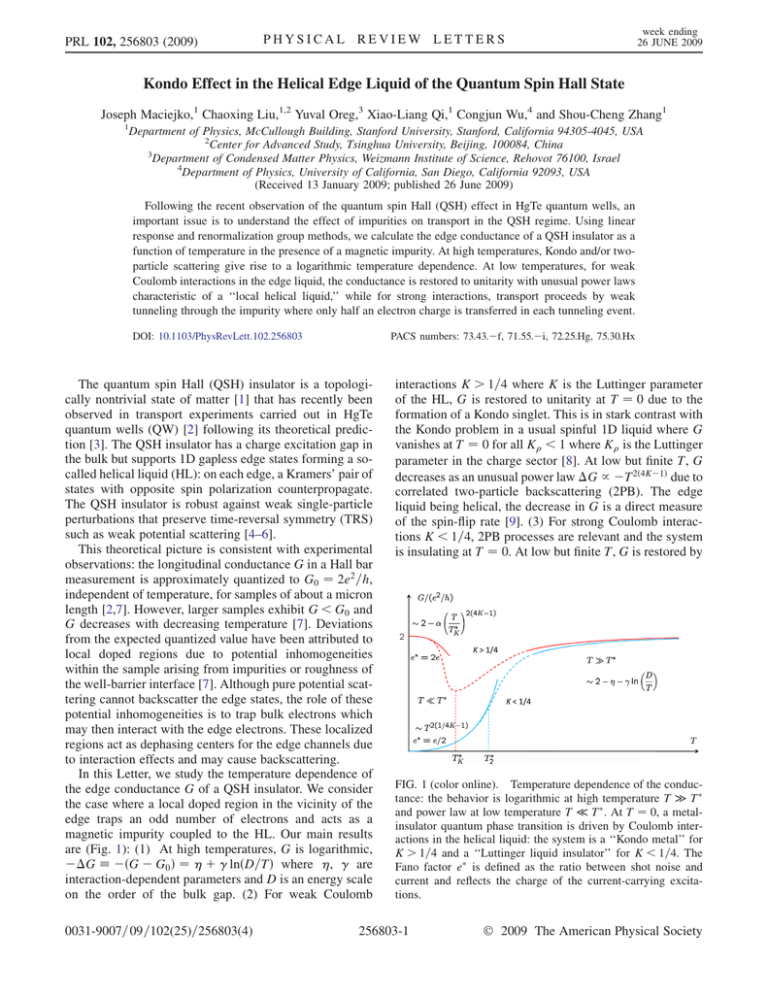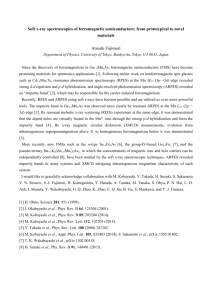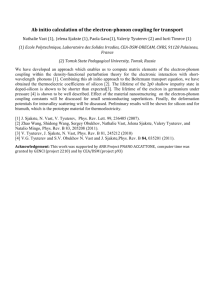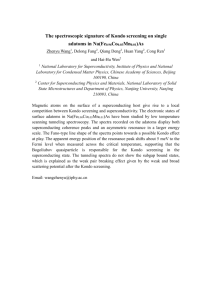Kondo Effect in the Helical Edge Liquid of the Quantum... Joseph Maciejko, Chaoxing Liu, Yuval Oreg,
advertisement

PRL 102, 256803 (2009) PHYSICAL REVIEW LETTERS week ending 26 JUNE 2009 Kondo Effect in the Helical Edge Liquid of the Quantum Spin Hall State Joseph Maciejko,1 Chaoxing Liu,1,2 Yuval Oreg,3 Xiao-Liang Qi,1 Congjun Wu,4 and Shou-Cheng Zhang1 1 Department of Physics, McCullough Building, Stanford University, Stanford, California 94305-4045, USA 2 Center for Advanced Study, Tsinghua University, Beijing, 100084, China 3 Department of Condensed Matter Physics, Weizmann Institute of Science, Rehovot 76100, Israel 4 Department of Physics, University of California, San Diego, California 92093, USA (Received 13 January 2009; published 26 June 2009) Following the recent observation of the quantum spin Hall (QSH) effect in HgTe quantum wells, an important issue is to understand the effect of impurities on transport in the QSH regime. Using linear response and renormalization group methods, we calculate the edge conductance of a QSH insulator as a function of temperature in the presence of a magnetic impurity. At high temperatures, Kondo and/or twoparticle scattering give rise to a logarithmic temperature dependence. At low temperatures, for weak Coulomb interactions in the edge liquid, the conductance is restored to unitarity with unusual power laws characteristic of a ‘‘local helical liquid,’’ while for strong interactions, transport proceeds by weak tunneling through the impurity where only half an electron charge is transferred in each tunneling event. DOI: 10.1103/PhysRevLett.102.256803 PACS numbers: 73.43.f, 71.55.i, 72.25.Hg, 75.30.Hx The quantum spin Hall (QSH) insulator is a topologically nontrivial state of matter [1] that has recently been observed in transport experiments carried out in HgTe quantum wells (QW) [2] following its theoretical prediction [3]. The QSH insulator has a charge excitation gap in the bulk but supports 1D gapless edge states forming a socalled helical liquid (HL): on each edge, a Kramers’ pair of states with opposite spin polarization counterpropagate. The QSH insulator is robust against weak single-particle perturbations that preserve time-reversal symmetry (TRS) such as weak potential scattering [4–6]. This theoretical picture is consistent with experimental observations: the longitudinal conductance G in a Hall bar measurement is approximately quantized to G0 ¼ 2e2 =h, independent of temperature, for samples of about a micron length [2,7]. However, larger samples exhibit G < G0 and G decreases with decreasing temperature [7]. Deviations from the expected quantized value have been attributed to local doped regions due to potential inhomogeneities within the sample arising from impurities or roughness of the well-barrier interface [7]. Although pure potential scattering cannot backscatter the edge states, the role of these potential inhomogeneities is to trap bulk electrons which may then interact with the edge electrons. These localized regions act as dephasing centers for the edge channels due to interaction effects and may cause backscattering. In this Letter, we study the temperature dependence of the edge conductance G of a QSH insulator. We consider the case where a local doped region in the vicinity of the edge traps an odd number of electrons and acts as a magnetic impurity coupled to the HL. Our main results are (Fig. 1): (1) At high temperatures, G is logarithmic, G ðG G0 Þ ¼ þ lnðD=TÞ where , are interaction-dependent parameters and D is an energy scale on the order of the bulk gap. (2) For weak Coulomb 0031-9007=09=102(25)=256803(4) interactions K > 1=4 where K is the Luttinger parameter of the HL, G is restored to unitarity at T ¼ 0 due to the formation of a Kondo singlet. This is in stark contrast with the Kondo problem in a usual spinful 1D liquid where G vanishes at T ¼ 0 for all K < 1 where K is the Luttinger parameter in the charge sector [8]. At low but finite T, G decreases as an unusual power law G / T 2ð4K1Þ due to correlated two-particle backscattering (2PB). The edge liquid being helical, the decrease in G is a direct measure of the spin-flip rate [9]. (3) For strong Coulomb interactions K < 1=4, 2PB processes are relevant and the system is insulating at T ¼ 0. At low but finite T, G is restored by FIG. 1 (color online). Temperature dependence of the conductance: the behavior is logarithmic at high temperature T T and power law at low temperature T T . At T ¼ 0, a metalinsulator quantum phase transition is driven by Coulomb interactions in the helical liquid: the system is a ‘‘Kondo metal’’ for K > 1=4 and a ‘‘Luttinger liquid insulator’’ for K < 1=4. The Fano factor e is defined as the ratio between shot noise and current and reflects the charge of the current-carrying excitations. 256803-1 Ó 2009 The American Physical Society PRL 102, 256803 (2009) tunneling of excitations with fractional charge e=2, and we obtain GðTÞ / T 2ð1=4K1Þ . Model.—We model the impurity by a S ¼ 12 local spin coupled by exchange to the 1D HL with Coulomb interactions. The HL having the same number of degrees of freedom as a spinless fermion, a single nonchiral boson is sufficient to bosonize the HL[5]. The system is described by the Hamiltonian H ¼ H0 þ HK þ H2 where H0 is the usual Tomonaga-Luttinger Hamiltonian H0 ¼ v2 R dx½K2 þ K1 ð@x Þ2 , with K the Luttinger parameter and v the edge state velocity. The Kondo Hamiltonian HK has the form HK ¼ week ending 26 JUNE 2009 PHYSICAL REVIEW LETTERS pffiffiffi Jk a Ja ðS : ei2 ð0Þ : þH:c:Þ pzffiffiffiffi Sz ð0Þ; (1) 2 where S ¼ Sx iSy and Sz are the spin operators for the impurity localized at x ¼ 0. a is the lattice constant of the underlying 2D lattice and corresponds to the size of the impurity (we assume that the impurity occupies a single lattice site). , the penetration length of the helical edge states into the bulk, acts as a short-distance cutoff for the 1D continuum theory in the same way that the magnetic length, the penetration length of the chiral edge states, acts as a short-distance cutoff for the chiral Luttinger liquid theory of the quantum Hall edge [10]. In addition to Kondo scattering, 2PB is allowed by TRS [5,6]. In HgTe QW, the wave vector where the edge dispersion enters the bulk is usually much smaller than =2a such that the uniform 2PB (umklapp) term requiring 4kF ¼ 2=a can be ignored. The impurity can however provide a 4kF momentum transfer, and we must generally also consider a local impuritypffiffiffiffi 2 a2 induced 2PB term [11] H2 ¼ 2 2 2 : cos4 ð0Þ: where 2 is the 2PB amplitude. Weak coupling regime.—We first consider the weak coupling regime where Jk ; Jz ; 2 are small parameters. We first calculate G to second order in the bare couplings Jk and 2 using the Kubo formula. This result is then extended to include all leading logarithmic terms in the perturbation expansion by means of a weak coupling renormalization group (RG) analysis of the scale-dependent couplings Jk ðTÞ and 2 ðTÞ where the scale is set by the temperature T. The Jz term can be removed from the Hamiltonian by a unitary transformation [12] of the form U ¼ pffiffiffiffi the eiSz ð0Þ with ¼ Jz a=vK , which changes pffiffiffi scaling dimension of the vertex operator : ei2 : . The ~ UHUy ¼ H0 þ H2 þ transformed Hamiltonian is H pffiffiffi Jk a i2 ð0Þ : þH:c:Þ, where ¼ 1 J =2K z 2 ðS : e with ¼ a=v the density of states of the HL. The scaling pffiffiffi ~ K2 . dimension of : ei2 : is K ~ we calculateGðTÞ ¼ GK ðTÞ þ G2 ðTÞ to Using H, second order in Jk and 2 using the Kubo formula, where GK is the correction due to Kondo scattering [13], ~ 2 ð12ÞðKÞ GK SðS þ 1Þ½Jk ðTÞ2 ; ¼ ~ 3 e2 =h ð12 þ KÞ (2) ~ where Jk ðTÞ ¼ Jk ðT=DÞK1 to OðJk Þ and D ¼ @v= is a high-energy cutoff on the order of the bulk gap. G2 is the correction due to 2PB, ð12Þð4KÞ a4 2 ðTÞ 2 G2 ¼ 1 ; (3) e2 =h ð2 þ 4KÞ 24 4 D where 2 ðTÞ ¼ 2 ðT=DÞ4K1 . There are no crossed terms of the form OðJk 2 Þ or OðJz 2 Þ for a S ¼ 12 impurity since the 2PB operator flips two spins but a S ¼ 12 spin can be flipped only once. We expect that such terms would be generated for impurities with higher spin. These results can be complemented by a RG analysis. The RG equation for 2 follows by dimensional analysis d2 d‘ ¼ ð1 4KÞ2 with ‘ ¼ lnðD=TÞ so that 2 is relevant for K < 1=4 and irrelevant for K > 1=4. The renormalized coupling is 2 ðTÞ ¼ 2 ðT=DÞ4K1 , and second order renormalized perturbation theory G2 ðTÞ / 2 ðTÞ2 simply reproduces the Kubo formula result (3). Perturbation theory fails for T & T2 where T2 / ð02 Þ1=ð14KÞ is a scale for the crossover from weak to strong 2PB with 02 the bare 2PB amplitude. The 1-loop RG equations [5,15] for the Kondo couplings Jk , Jz read dJk ¼ ð1 KÞJk þ Jk Jz ; d‘ dJz ¼ Jk2 : d‘ (4) The family of RG trajectories is indexed by a single scaling invariant c ¼ ðJk Þ2 ðJ~z Þ2 where J~z Jz þ 1 K, which is fixed by the couplings at energy scale D. In contrast to the spinful case [8], the absence of spin-flip forward scattering in the HL preserves the stability of the ferromagnetic fixed line, as is the case in the usual Kondo problem. The renormalized spin-flip amplitude Jk ðTÞ is given in terms of the bare parameters Jk0 , Jz0 by Jk ðTÞ ¼ Jk0 sinh½ Jk0 lnðT=TK Þ ; (5) such that GK is obtained to all orders in perturbation theory in the leading-log approximation by substituting Eq. (5) in Eq. (2). In Eq. (5), ¼ ½ðJ~0z =Jk0 Þ2 11=2 is an anisotropy parameter [16] and TK is the Kondo temperature, 1 arcsinh : TK ¼ D exp 0 Jk In the isotropic case ¼ 0, one recovers the usual form 0 TK ¼ De1=Jk . In the limit 1 K Jk0 , Jz0 , Coulomb interactions0 dominate over Kondo physics, and we obtain J TK ’ Dð1Kk Þ1=ð1KÞ , a power-law form similar to the result for spinful Luttinger liquids [17] . From the exponent, we see that TK corresponds to the scale of the mass gap opened 256803-2 PRL 102, 256803 (2009) PHYSICAL REVIEW LETTERS in a spinless Luttinger liquid by a nonmagnetic impurity of strength Jk0 and the corresponding crossover is that of weak to strong single-particle backscattering. In the high-temperature limit maxfT2 ; TK g T & D, both the Kondo and 2PB processes contribute logarithmically to the suppression of G, GðTÞ þ lnðD=TÞ where , are functions of the bare couplings K, Jk0 , Jz0 , and 02 . Strong coupling regime.—We now investigate the low temperature regime T minfT2 ; TK g. The topological nature of the QSH edge state as a ‘‘holographic liquid’’ living on the boundary of a 2D system [5] results in a drastic change of the low-energy effective theory in the vicinity of the strong coupling fixed point as compared to that of a usual 1D quantum wire. As suggested by the perturbative RG analysis, the nature of the T ¼ 0 fixed point depends on whether K is greater or lesser than 1=4. For K > 1=4, 2PB is irrelevant and G2 flows to zero. On the other hand, for antiferromagnetic Jz the Kondo strong coupling fixed point Jk , Jz ! þ1 is reached at T ¼ 0, with formation of a local Kramers singlet and complete screening of the impurity spin by the HL. As a result, the formation of the Kondo singlet effectively removes the impurity site from the underlying 2D lattice [Fig. 2(b)]. In a strictly 1D spinful liquid, this has the effect of cutting the system into two disconnected semi-infinite 1D liquids [Fig. 2(a)] and transport is blocked at T ¼ 0 for all K < 1 [8]. In contrast, due to its topological nature, the QSH edge state simply follows the new shape of the edge, and we expect the unitarity limit G ¼ G0 to be restored at T ¼ 0. For finite T TK , the effective low-energy Hamiltonian contains the leading irrelevant operators in the vicinity of the fixed point. In the case of spinful conduction electrons, the lowest-dimensional operator causing a reduction of G is single-particle backscattering. However, the helical property of the QSH edge states forbids such a term, and it is natural to conjecture that the leading irrelevant operator must be the 2PB operator with scaling dimension 4K. We thus expect a correction to G at low temperatures T TK for K > 1=4 of the form G / ðT=TK Þ2ð4K1Þ . In particular, in the noninteracting case K ¼ 1, we predict a T 6 dependence in marked contrast to both the usual Fermi liquid [18] and spinful 1D liquid [8] behaviors. This dependence characteristic of a ‘‘local helical Fermi liquid’’ can be understood from a simple phase space argument. The Pauli principle requires the 2PB operator to be defined through point-splitting [5] with the shortdistance cutoff , which translates into a derivative coupling c yR ð0Þ c yR ðÞ c L ð0Þ c L ðÞ ! 2 c yR @x c yR c L @x c L in the limit of small . In the absence of derivatives, the 4-fermion term contributes T 2 to the inverse lifetime 1 k . The derivatives correspond to four powers of momenta close to the Fermi points in the scattering rate k;k0 !p;p0 / ðk k0 Þ2 ðp p0 Þ2 , which translates into an additional factor of T 4 . Furthermore, since for T TK , the suppression of G is entirely due to 2PB, we expect the effective charge week ending 26 JUNE 2009 FIG. 2 (color online). Strong coupling regime: the Kondo singlet effectively removes one site from the system. (a) Luttinger liquid with K < 1: a punctured 1D lattice is disconnected, (b) QSH edge liquid with K > 1=4: the edge liquid follows the boundary of the deformed 2D lattice. (c) Half-charge tunneling for K < 1=4 by flips of the Ising order parameter m. e S=ð2jhIB ijÞ obtained from a measurement of the shot noise S in the backscattering current hIB i to be e ¼ 2e [11,19]. For K < 1=4, the j2 j ! 1 fixed point is reached at T ¼ 0 and the system is insulating. The field ðx ¼ 0; Þ is pinned at the pffiffiffiffiminima of the cosine potential pffiffiffiffi H2 located at ð2n þ 1Þ =4 for 2 > 0 and 2n =4 for 2 < 0, with n 2 Z. G is restored at finite T by instanton processes corresponding toptunneling between nearby minima sepaffiffiffiffi pffiffiffiffi rated by ¼ =2. From the relation je ¼ e@t = where je is the electric current, the charge pumped by a single instanton [Fig. 2(c)] is Qinst ¼ peffiffiffi ¼ 2e . This fractionalized tunneling current can be understood as the Goldstone-Wilczek current [20–22] for 1D Dirac fermions 1 þ i5 m2 Þ where g with a mass term L ¼ gðm pffiffiffiffi 2 , and pffiffiffiffi the mass order parameters m1 ¼ cos2 , m2 ¼ sin2 change sign during an instanton process. The order is Ising-like because the 2PB term explicitly breaks the symmetry of the helical liquid H0 ¼ v 2 R spin Uð1Þ 1 2 2 dxðKz þ K Þ down to Z2 , where z ¼ þ and ¼ þ þ are the spin and charge densities, and are the chiral densities for the two members of the Kramers pair. Fractionalization of the tunneling current is confirmed by a saddle-point evaluation of the low-energy effective action Seff for large 2 in the dilute instanton gas approximation, which yields a Coulomb gas model that can be mapped exactly to the boundary sine-Gordon theory Seff ½ ¼ Z pffiffiffiffi KX j!n jjði!n Þj2 þ t d cos ðÞ; i!n 0 where t is the instanton fugacity. The RG equation for t dt 1 follows as d‘ ¼ ð1 4K Þt and GðTÞ / tðTÞ2 is a power law G / ðT=T2 Þ2ð1=4K1Þ for T T2 , K < 1=4. In contrast to the strong coupling regime in a usual Luttinger liquid 256803-3 PRL 102, 256803 (2009) PHYSICAL REVIEW LETTERS where t corresponds to a single-particle hopping amplitude [23], the unusual scaling dimension of the tunneling operator in the present case corresponds to half-charge tunneling. In particular, we calculate the shot noise in the strong coupling regime using the Keldysh approach [24] and find S ¼ 2e jhIij where hIi is the tunneling current and e ¼ e=2. Experimental realization.—We find that the experimental results of Ref. [7] are consistent with our expressions for the weak coupling regime with a weak Luttinger parameter K ’ 1, but the small number of available data points does not allow for a reliable determination of the model parameters. The temperature dependence of the conductance being exponentially sensitive to K, our predictions can be best verified in QW with stronger interaction effects. Because of reduced screening of the Coulomb interaction [25], we expect to see a steeper decrease of conductance with decreasing temperature in HgTe samples with only a backgate. Because of lower Fermi velocities vF , we expect even stronger interaction effects to occur in InAs=GaSb=AlSb type-II QW which are predicted to exhibit the QSH effect [26]. For QW widths wInAs ¼ wGaSb ¼ 10 nm and considering only screening from the front gate closest to the QW layer, from a k p calculation of material parameters, we obtain K ’ 0:2 < 1=4, making the insulating phase observable at low temperatures. Although the backgate will cause additional screening, vF can be further decreased by adding a thin AlSb barrier layer between the InAs and GaSb QW layers. vF is controlled by the overlap between electron and hole subband wave functions [3] which are localized in different layers for type-II QW [26], and an additional barrier layer will decrease this overlap. A lower vF also translates into higher TK since J / 1=v2F , where one factor of vF comes from the matrix element of the localized impurity potential between edge states, and the other factor comes from the density of states . Since TK depends on J exponentially, we expect an experimentally accessible TK in type-II QW. We are grateful to E.-A. Kim, T. Hughes, M. König, E. Berg, T. Ong, A. Furusaki, H. Yao, and S. Raghu for valuable discussions. J. M. is supported by NSERC of Canada and FQRNT, and the Stanford Graduate Program. C. X. L. is supported by the CSC, NSF under Grant Nos. 10774086, 10574076, and Basic Research Development of China under Grant Number 2006CB921500. Y. O. is supported by BSF, DIP, and GIF grants, the Mel Schwartz Research Fund, an NSF CAREER Grant No. DMR-0349354, and the SITP. C. W. is supported by the NSF under Grant No. DMR-0804775, the Sloan Research Foundation, and the Army Research Office under Grant No. W911NF0810291. S. C. Z. is supported by the U.S. Department of Energy, Office of Basic Energy Sciences under Contract No. DE-AC03-76SF00515. week ending 26 JUNE 2009 [1] For a review, see M. König et al., J. Phys. Soc. Jpn. 77, 031007 (2008). [2] M. König et al., Science 318, 766 (2007). [3] B. A. Bernevig, T. L. Hughes, and S. C. Zhang, Science 314, 1757 (2006). [4] C. L. Kane and E. J. Mele, Phys. Rev. Lett. 95, 226801 (2005). [5] C. Wu, B. A. Bernevig, and S. C. Zhang, Phys. Rev. Lett. 96, 106401 (2006). [6] C. Xu and J. E. Moore, Phys. Rev. B 73, 045322 (2006). [7] M. König, Ph.D. thesis, University of Würzburg, 2007. [8] A. Furusaki and N. Nagaosa, Phys. Rev. Lett. 72, 892 (1994). [9] M. Garst, P. Wölfle, L. Borda, J. von Delft, and L. Glazman, Phys. Rev. B 72, 205125 (2005). [10] X.-G. Wen, Phys. Rev. B 44, 5708 (1991). [11] D. Meidan and Y. Oreg, Phys. Rev. B 72, 121312(R) (2005). [12] V. J. Emery and S. Kivelson, Phys. Rev. B 46, 10812 (1992). [13] This result holds for @v=L T < D and for Fermi liquid leads [14] where L is the length of the QSH region. [14] D. L. Maslov, Phys. Rev. B 52, R14368 (1995). [15] A. Schiller and K. Ingersent, Phys. Rev. B 51, 4676 (1995). [16] The Kondo model derived from the Anderson model for a single level coupled to the HL is isotropic due to TRS with 1 1 þ d þU Þ where F is the Jk0 ¼ Jz0 ¼ ðjtj2 þ juj2 ÞðF d F Fermi energy, d is the impurity level with on-site Coulomb repulsion U, and u; t are the spin-flip and nonspin-flip hopping amplitudes, respectively. Coulomb interactions (K 1) may however induce an effective anisotropy ( 0) even if the original Kondo model is isotropic. [17] D.-H. Lee and J. Toner, Phys. Rev. Lett. 69, 3378 (1992). [18] P. Nozières, J. Low Temp. Phys. 17, 31 (1974). [19] In the high temperature regime T T2 , TK , both the Kondo (e ¼ e) and 2PB (e ¼ 2e) contributions to the effective carrier charge are present, such that we expect a nonuniversal value for the Fano factor. [20] J. Goldstone and F. Wilczek, Phys. Rev. Lett. 47, 986 (1981). [21] X. L. Qi, T. L. Hughes, and S. C. Zhang, Nature Phys. 4, 273 (2008). [22] X. L. Qi, T. L. Hughes, and S. C. Zhang, Phys. Rev. B 78, 195424 (2008). [23] C. L. Kane and M. P. A. Fisher, Phys. Rev. B 46, 15233 (1992). [24] T. Martin, arXiv: cond-mat/0501208. [25] K can be estimated [23] by K ¼ ½1 þ lnðd=‘Þ1=2 2 e2 = where ¼ 2 @vF and is the bulk dielectric constant. The distance d from the QW layer to a nearby metallic gate acts as a screening length for the Coulomb potential, and ‘ is a microscopic length scale ‘ ¼ maxf; wg which acts as a short-distance cutoff for the Coulomb potential, where w is the thickness of the QW layer. [26] C. Liu, T. L. Hughes, X. L. Qi, K. Wang, and S. C. Zhang, Phys. Rev. Lett. 100, 236601 (2008). 256803-4





